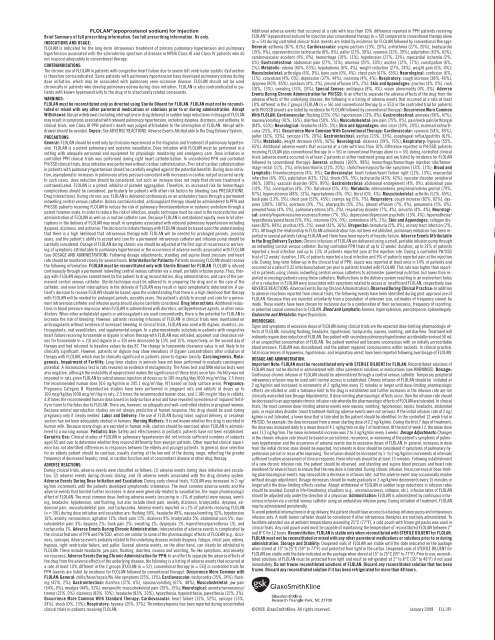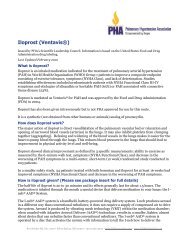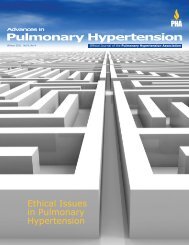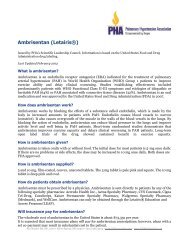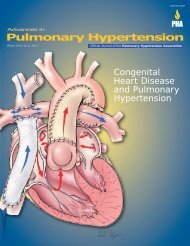Vol 7, No 3 - PHA Online University
Vol 7, No 3 - PHA Online University
Vol 7, No 3 - PHA Online University
You also want an ePaper? Increase the reach of your titles
YUMPU automatically turns print PDFs into web optimized ePapers that Google loves.
FLOLAN ® (epoprostenol sodium) for Injection<br />
Brief Summary of full prescribing information. See full prescribing information. Rx only.<br />
INDICATIONS AND USAGE:<br />
FLOLAN is indicated for the long-term intravenous treatment of primary pulmonary hypertension and pulmonary<br />
hyperten sion associated with the scleroderma spectrum of disease in NYHA Class III and Class IV patients who do<br />
not respond ade quately to conventional therapy.<br />
CONTRAINDICATIONS:<br />
The chron ic use of FLOLAN in patients with congestive heart failure due to severe left ventricular systolic dysfunction<br />
is therefore con traindicated. Some patients with pulmonary hypertension have developed pulmonary edema during<br />
dose initiation, which may be asso ciated with pulmonary veno-occlusive disease. FLOLAN should not be used<br />
chronically in patients who develop pulmonary edema during dose initiation. FLOLAN is also contraindicated in patients<br />
with known hypersensitivity to the drug or to structurally related compounds.<br />
WARNINGS:<br />
FLOLAN must be reconstituted only as directed using Sterile Diluent for FLOLAN. FLOLAN must not be reconstituted<br />
or mixed with any other parenteral medications or solutions prior to or during administration. Abrupt<br />
Withdrawal: Abrupt withdrawal (including interruptions in drug delivery) or sudden large reductions in dosage of FLOLAN<br />
may result in symptoms associated with rebound pulmonary hypertension, including dyspnea, dizziness, and asthenia. In<br />
clinical trials, one Class III PPH patient’s death was judged attributable to the interruption of FLOLAN. Abrupt withdrawal<br />
should be avoided. Sepsis: See ADVERSE REACTIONS: Adverse Events Attributable to the Drug Delivery System.<br />
PRECAUTIONS:<br />
General: FLOLAN should be used only by clinicians experienced in the diagnosis and treatment of pulmonary hypertension.<br />
FLOLAN is a potent pulmonary and systemic vasodilator. Dose initiation with FLOLAN must be performed in a<br />
setting with adequate personnel and equipment for physiologic monitoring and emergency care. Dose initiation in<br />
controlled PPH clini cal trials was performed during right heart catheterization. In uncontrolled PPH and controlled<br />
PH/SSD clinical trials, dose initiation was performed without cardiac catheterization. The risk of cardiac catheterization<br />
in patients with pulmonary hyper tension should be carefully weighed against the potential benefi ts. During dose initiation,<br />
asymptomatic increases in pul monary artery pressure coincident with increases in cardiac output occurred rarely.<br />
In such cases, dose reduction should be considered, but such an increase does not imply that chronic treatment is<br />
contraindicated. FLOLAN is a potent inhibitor of platelet aggregation. Therefore, an increased risk for hemorrhagic<br />
complications should be considered, particularly for patients with other risk factors for bleeding (see PRECAUTIONS:<br />
Drug Interactions). During chronic use, FLOLAN is delivered continuously on an ambulatory basis through a permanent<br />
indwelling central venous catheter. Unless contraindicated, anticoagulant therapy should be administered to PPH and<br />
PH/SSD patients receiv ing FLOLAN to reduce the risk of pulmonary thromboembolism or systemic embolism through a<br />
patent foramen ovale. In order to reduce the risk of infection, aseptic technique must be used in the reconstitution and<br />
administration of FLOLAN as well as in routine catheter care. Because FLOLAN is metabolized rapidly, even brief interruptions<br />
in the delivery of FLOLAN may result in symptoms associated with rebound pulmonary hypertension including<br />
dyspnea, dizziness, and asthenia. The decision to initiate therapy with FLOLAN should be based upon the understanding<br />
that there is a high likelihood that intra venous therapy with FLOLAN will be needed for prolonged periods, possibly<br />
years, and the patient’s ability to accept and care for a permanent intravenous catheter and infusion pump should be<br />
carefully considered. Dosage of FLOLAN during chronic use should be adjusted at the fi rst sign of recurrence or worsening<br />
of symptoms attributable to pulmonary hypertension or the occurrence of adverse events associated with FLOLAN<br />
(see DOSAGE AND ADMINISTRATION). Following dosage adjustments, standing and supine blood pressure and heart<br />
rate should be monitored closely for several hours. Information for Patients: Patients receiving FLOLAN should receive<br />
the following information. FLOLAN must be recon stituted only with Sterile Diluent for FLOLAN. FLOLAN is infused<br />
continuously through a permanent indwelling central venous catheter via a small, portable infusion pump. Thus, therapy<br />
with FLOLAN requires commitment by the patient to drug reconstitution, drug administration, and care of the permanent<br />
central venous catheter. Sterile technique must be adhered to in preparing the drug and in the care of the<br />
catheter, and even brief interruptions in the delivery of FLOLAN may result in rapid symptomatic deterioration. A patient’s<br />
decision to receive FLOLAN should be based upon the understanding that there is a high likelihood that therapy<br />
with FLOLAN will be needed for prolonged periods, possibly years. The patient’s ability to accept and care for a permanent<br />
intravenous catheter and infusion pump should also be carefully considered. Drug Interactions: Additional reductions<br />
in blood pressure may occur when FLOLAN is administered with diuretics, antihypertensive agents, or other vasodilators.<br />
When other antiplatelet agents or anticoagulants are used concomitantly, there is the potential for FLOLAN to<br />
increase the risk of bleeding. However, patients receiving infusions of FLOLAN in clinical trials were maintained on<br />
anticoagulants without evidence of increased bleeding. In clinical trials, FLOLAN was used with digoxin, diuretics, anticoagulants,<br />
oral vasodilators, and supplemental oxygen. In a pharmacokinetic substudy in patients with congestive<br />
heart failure receiving furosemide or digoxin in whom therapy with FLOLAN was initiated, apparent oral clearance values<br />
for furosemide (n = 23) and digoxin (n = 30) were decreased by 13% and 15%, respectively, on the second day of<br />
therapy and had returned to baseline values by day 87. The change in furosemide clearance value is not likely to be<br />
clinically signifi cant. However, patients on digoxin may show elevations of digoxin concentrations after initiation of<br />
therapy with FLOLAN, which may be clinically signifi cant in patients prone to digoxin toxicity. Carcinogenesis, Mutagenesis,<br />
Impairment of Fertility: Long-term studies in animals have not been performed to evaluate carcinogenic<br />
potential. A micronucleus test in rats revealed no evidence of mutagenicity. The Ames test and DNA elution tests were<br />
also negative, although the instability of epoprostenol makes the signifi cance of these tests uncertain. Fertility was not<br />
impaired in rats given FLOLAN by subcutaneous injection at doses up to 100 mcg/kg/day (600 mcg/m 2 /day, 2.5 times<br />
the recommended human dose [4.6 ng/kg/min or 245.1 mcg/m 2 /day, IV] based on body surface area). Pregnancy:<br />
Pregnancy Category B. Reproductive studies have been performed in pregnant rats and rabbits at doses up to<br />
100 mcg/kg/day (600 mcg/m 2 /day in rats, 2.5 times the recommended human dose, and 1,180 mcg/m 2 /day in rabbits,<br />
4.8 times the recommended human dose based on body surface area) and have revealed no evidence of impaired fertility<br />
or harm to the fetus due to FLOLAN. There are, however, no adequate and well-controlled studies in pregnant women.<br />
Because animal reproduction studies are not always predictive of human response, this drug should be used during<br />
pregnancy only if clearly needed. Labor and Delivery: The use of FLOLAN during labor, vaginal delivery, or cesarean<br />
section has not been adequately studied in humans. Nursing Mothers: It is not known whether this drug is excreted in<br />
human milk. Because many drugs are excreted in human milk, caution should be exercised when FLOLAN is administered<br />
to a nursing woman. Pediatric Use: Safety and effectiveness in pediatric patients have not been established.<br />
Geriatric Use: Clinical studies of FLOLAN in pulmonary hypertension did not include suffi cient numbers of subjects<br />
aged 65 and over to determine whether they respond differently from younger patients. Other reported clinical experience<br />
has not identifi ed differences in responses between the elderly and younger patients. In general, dose selection<br />
for an elderly patient should be cautious, usually starting at the low end of the dosing range, refl ecting the greater<br />
frequency of decreased hepatic, renal, or cardiac function and of concomitant disease or other drug therapy.<br />
ADVERSE REACTIONS:<br />
During clinical trials, adverse events were classifi ed as follows: (1) adverse events during dose initiation and escalation,<br />
(2) adverse events during chronic dosing, and (3) adverse events associated with the drug delivery system.<br />
Adverse Events During Dose Initiation and Escalation: During early clinical trials, FLOLAN was increased in 2-ng/<br />
kg/min increments until the patients developed symptomatic intolerance. The most common adverse events and the<br />
adverse events that limited further increases in dose were generally related to vasodilation, the major pharmacologic<br />
effect of FLOLAN. The most common dose-limiting adverse events (occurring in ≥1% of patients) were nausea, vomiting,<br />
headache, hypoten sion, and fl ushing, but also include chest pain, anxiety, dizziness, bradycardia, dyspnea, abdominal<br />
pain, musculoskeletal pain, and tachycardia. Adverse events reported in ≥1% of patients receiving FLOLAN<br />
(n = 391) during dose initiation and escalation are: fl ushing 58%; headache 49%; nausea/vomiting 32%; hypotension<br />
16%; anxiety, nervousness, agitation 11%; chest pain 11%; dizziness 8%; bradycardia 5%; abdominal pain 5%; musculoskeletal<br />
pain 3%; dyspnea 2%; back pain 2%; sweating 1%; dyspepsia 1%; hypesthesia/paresthesia 1%; and<br />
t ach y c ar dia 1%. Adverse Events During Chronic Administration: Interpretation of adverse events is complicated by<br />
the clinical features of PPH and PH/SSD, which are similar to some of the pharmacologic effects of FLOLAN (e.g., dizziness,<br />
syncope). Adverse events probably related to the underlying disease include dyspnea, fatigue, chest pain, edema,<br />
hypoxia, right ventricular fail ure, and pallor. Several adverse events, on the other hand, can clearly be attributed to<br />
FLOLAN. These include headache, jaw pain, fl ushing, diarrhea, nausea and vomiting, fl u-like symptoms, and anxiety/<br />
nervousness. Adverse Events During Chronic Administration for PPH: In an effort to separate the adverse effects of<br />
the drug from the adverse effects of the underlying disease, the following is a listing of adverse events that occurred at<br />
a rate at least 10% dif ferent in the 2 groups [FLOLAN (n = 52), conventional therapy (n = 54)] in controlled trials for<br />
PPH (events are listed by incidence for FLOLAN followed by conventional therapy): Occurrence More Common with<br />
FLOLAN: General: chills/fever/sepsis/fl u-like symptoms (25%, 11%); Cardiovascular: tachycardia (35%, 24%), fl ushing<br />
(42%, 2%); Gastrointestinal: diarrhea (37%, 6%), nausea/vomiting (67%, 48%); Musculoskeletal: jaw pain<br />
(54%, 0%), myalgia (44%, 31%), nonspecifi c musculoskeletal pain (35%, 15%); Neurological: anxiety/nervousness/<br />
tremor (21%, 9%), dizziness (83%, 70%), headache (83%, 33%), hypesthesia, hyper esthesia, paresthesia (12%, 2%).<br />
Occurrence More Common With Standard Therapy: Cardiovascular: heart failure (31%, 52%), syncope (13%,<br />
24%), shock (0%, 13%); Respiratory: hypoxia (25%, 37%). Thrombocytopenia has been reported during uncontrolled<br />
clinical trials in patients receiving FLOLAN.<br />
Additional adverse events that occurred at a rate with less than 10% difference reported in PPH patients receiving<br />
FLOLAN ® (epoprostenol sodium) for injection plus conventional therapy (n = 52) compared to conventional therapy alone<br />
(n = 54) during controlled clinical trials (events are listed by incidence for FLOLAN followed by conventional therapy):<br />
General: asthenia (87%, 81%); Cardiovascular: angina pectoris (19%, 20%), arrhythmia (27%, 20%), bradycardia<br />
(15%, 9%), supraventricu lar tachycardia (8%, 0%), pallor (21%, 30%), cyanosis (31%, 39%), palpitation (63%, 61%),<br />
cerebrovascular accident (4%, 0%), hemorrhage (19%, 11%), hypotension (27%, 31%), myocardial ischemia (2%,<br />
6%); Gastrointestinal: abdominal pain (27%, 31%), anorexia (25%, 30%), ascites (12%, 17%), constipation (6%,<br />
2%); Metabolic: edema (60%, 63%), hypokalemia (6%, 4%), weight reduction (27%, 24%), weight gain (6%, 4%);<br />
Musculoskeletal: arthralgia (6%, 0%), bone pain (0%, 4%), chest pain (67%, 65%); Neurological: confusion (6%,<br />
11%), convulsion (4%, 0%), depression (37%, 44%), insomnia (4%, 4%); Respiratory: cough increase (38%, 46%),<br />
dyspnea (90%, 85%), epistaxis (4%, 2%), pleural effusion (4%, 2%); Skin and Appendages: pruritus (4%, 0%), rash<br />
(10%, 13%), sweating (15%, 20%); Special Senses: amblyopia (8%, 4%), vision abnormality (4%, 0%). Adverse<br />
Events During Chronic Administration for PH/SSD: In an effort to separate the adverse effects of the drug from the<br />
adverse effects of the underlying disease, the following is a listing of adverse events that occurred at a rate at least<br />
10% different in the 2 groups [FLOLAN (n = 56) and conventional therapy (n = 55)] in the controlled trial for patients<br />
with PH/SSD (events are listed by incidence for FLOLAN followed by conventional therapy): Occurrence More Common<br />
With FLOLAN: Cardiovascular: fl ushing (23%, 0%), hypotension (13%, 0%); Gastrointestinal: anorexia (66%, 47%),<br />
nausea/vomiting (41%, 16%), diarrhea (50%, 5%); Musculoskeletal: jaw pain (75%, 0%), pain/neck pain/arthralgia<br />
(84%, 65%); Neurological: headache (46%, 5%); Skin and Appendages: skin ulcer (39%, 24%), eczema/rash/urticaria<br />
(25%, 4%). Occurrence More Common With Conventional Therapy: Cardiovascular: cyanosis (54%, 80%),<br />
pallor (32%, 53%), syncope (7%, 20%); Gastrointestinal: ascites (23%, 33%), esophageal refl ux/gastritis (61%,<br />
73%); Metabolic: weight decrease (45%, 56%); Neurological: dizziness (59%, 76%); Respiratory: hypoxia (55%,<br />
65%). Additional adverse events that occurred at a rate with less than 10% difference reported in PH/SSD patients<br />
receiving FLOLAN plus conventional therapy (n = 56) or conventional therapy alone (n = 55) during controlled clinical<br />
trials (adverse events occurred in at least 2 patients in either treatment group and are listed by inci dence for FLOLAN<br />
followed by conventional therapy): General: asthenia (100%, 98%), hemorrhage/hemorrhage injection site/hemorrhage<br />
rectal (11%, 2%), infection/rhinitis (21%, 20%), chills/fever/sepsis/fl u-like symptoms (13%, 11%); Blood and<br />
Lymphatic: thrombocytopenia (4%, 0%); Cardiovascular: heart failure/heart failure right (11%, 13%), myocardial<br />
infarction (4%, 0%), palpitation (63%, 71%), shock (5%, 5%), tachycardia (43%, 42%), vascular disorder peripheral<br />
(96%, 100%), vascular disorder (95%, 89%); Gastrointestinal: abdominal enlargement (4%, 0%), abdominal pain<br />
(14%, 7%), con stipation (4%, 2%), fl atulence (5%, 4%); Metabolic: edema/edema peripheral/edema genital (79%,<br />
87%), hypercalcemia (48%, 51%), hyperkalemia (4%, 0%), thirst (0%, 4%); Musculoskeletal: arthritis (52%, 45%),<br />
back pain (13%, 5%), chest pain (52%, 45%), cramps leg (5%, 7%); Respiratory: cough increase (82%, 82%), dyspnea<br />
(100%, 100%), epistaxis (9%, 7%), pharyngitis (5%, 2%), pleural effusion (7%, 0%), pneumonia (5%, 0%),<br />
pneumothorax (4%, 0%), pulmonary edema (4%, 2%), respiratory disorder (7%, 4%), sinusitis (4%, 4%); Neurological:<br />
anxiety/hyperkinesia/nervousness/tremor (7%, 5%), depression/depression psychotic (13%, 4%), hyperesthesia/<br />
hypesthesia/paresthesia (5%, 0%), insomnia (9%, 0%), somnolence (4%, 2%); Skin and Appendages: collagen disease<br />
(82%, 84%), pruritus (4%, 2%), sweat (41%, 36%); Urogenital: hematuria (5%, 0%), urinary tract infection (7%,<br />
0%). Although the relationship to FLOLAN administration has not been established, pulmonary embolism has been reported<br />
in several patients taking FLOLAN and there have been reports of hepatic failure. Adverse Events Attributable<br />
to the Drug Delivery System: Chronic infusions of FLOLAN are delivered using a small, portable infusion pump through<br />
an indwelling central venous catheter. During controlled PPH trials of up to 12 weeks’ dura tion, up to 21% of patients<br />
reported a local infection and up to 13% of patients reported pain at the injection site. During a controlled PH/SSD<br />
trial of 12 weeks’ duration, 14% of patients reported a local infection and 9% of patients reported pain at the injection<br />
site. During long-term follow-up in the clinical trial of PPH, sepsis was reported at least once in 14% of patients and<br />
occurred at a rate of 0.32 infections/patient per year in patients treated with FLOLAN. This rate was higher than reported<br />
in patients using chronic indwelling central venous catheters to administer parenteral nutrition, but lower than reported<br />
in oncology patients using these catheters. Malfunctions in the delivery system resulting in an inadvertent bolus<br />
of or a reduc tion in FLOLAN were associated with symptoms related to excess or insuffi cient FLOLAN, respectively (see<br />
ADVERSE REACTIONS: Adverse Events During Chronic Administration). Observed During Clinical Practice: In addition<br />
to adverse reactions reported from clinical trials, the following events have been identifi ed during post-approval use of<br />
FLOLAN. Because they are reported voluntarily from a population of unknown size, estimates of frequency cannot be<br />
made. These events have been chosen for inclusion due to a combination of their seriousness, frequency of reporting,<br />
or potential causal connection to FLOLAN. Blood and Lymphatic: Anemia, hypersplenism, pancytopenia, splenomegaly.<br />
Endocrine and Metabolic: Hyperthyroidism.<br />
OVERDOSAGE:<br />
Signs and symptoms of excessive doses of FLOLAN during clinical trials are the expected dose-limiting pharmacologic effects<br />
of FLOLAN, including flushing, headache, hypotension, tachycardia, nausea, vomiting, and diarrhea. Treatment will<br />
ordinarily require dose reduction of FLOLAN. One patient with secondary pulmonary hypertension accidentally received 50 mL<br />
of an unspecifi ed concentration of FLOLAN. The patient vomited and became unconscious with an initially unrecordable<br />
blood pressure. FLOLAN was dis continued and the patient regained consciousness within seconds. In clinical practice,<br />
fatal occurrences of hypoxemia, hypotension, and respiratory arrest have been reported following overdosage of FLOLAN.<br />
DOSAGE AND ADMINISTRATION:<br />
Important <strong>No</strong>te: FLOLAN must be reconstituted only with STERILE DILUENT for FLOLAN. Reconstituted solutions of<br />
FLOLAN must not be diluted or administered with other parenteral solutions or medications (see WARNINGS). Dosage:<br />
Continuous chronic infusion of FLOLAN should be administered through a central venous catheter. Temporary peripheral<br />
intravenous infusion may be used until central access is established. Chronic infusion of FLOLAN should be ini tiated at<br />
2 ng/kg/min and increased in increments of 2 ng/kg/min every 15 minutes or longer until dose-limiting pharmaco logic<br />
effects are elicited or until a tolerance limit to the drug is established and further increases in the infusion rate are not<br />
clinically warranted (see Dosage Adjustments). If dose-limiting pharmacologic effects occur, then the infusion rate should<br />
be decreased to an appropriate chronic infusion rate whereby the pharmacologic effects of FLOLAN are tolerated. In clinical<br />
tri als, the most common dose-limiting adverse events were nausea, vomiting, hypotension, sepsis, headache, abdominal<br />
pain, or respiratory disorder (most treatment-limiting adverse events were not serious). If the initial infusion rate of 2 ng/<br />
kg/min is not tolerated, a lower dose that is tolerated by the patient should be identifi ed. In the controlled 12-week trial in<br />
PH/SSD, for example, the dose increased from a mean starting dose of 2.2 ng/kg/min. During the first 7 days of treatment,<br />
the dose was increased daily to a mean dose of 4.1 ng/kg/min on day 7 of treatment. At the end of week 12, the mean dose<br />
was 11.2 ng/kg/min. The mean incremental increase was 2 to 3 ng/kg/min every 3 weeks. Dosage Adjustments: Changes<br />
in the chronic infusion rate should be based on persistence, recurrence, or worsening of the patient’s symptoms of pulmonary<br />
hypertension and the occurrence of adverse events due to excessive doses of FLOLAN. In general, increases in dose<br />
from the initial chronic dose should be expected. Increments in dose should be considered if symptoms of pulmonary hypertension<br />
persist or recur after improving. The infu sion should be increased by 1- to 2-ng/kg/min increments at intervals<br />
suffi cient to allow assessment of clinical response; these intervals should be at least 15 minutes. Following establishment<br />
of a new chronic infusion rate, the patient should be observed, and standing and supine blood pressure and heart rate<br />
monitored for several hours to ensure that the new dose is tolerated. During chronic infusion, the occurrence of dose-limiting<br />
pharmacological events may necessitate a decrease in infusion rate, but the adverse event may occasionally resolve<br />
without dosage adjustment. Dosage decreases should be made gradually in 2-ng/kg/min decrements every 15 minutes or<br />
longer until the dose-limiting effects resolve. Abrupt withdrawal of FLOLAN or sudden large reductions in infusion rates<br />
should be avoided. Except in life-threatening situations (e.g., unconsciousness, collapse, etc.), infusion rates of FLOLAN<br />
should be adjusted only under the direction of a physician. Administration: FLOLAN is administered by continuous intravenous<br />
infusion via a central venous catheter using an ambu latory infusion pump. During initiation of treatment, FLOLAN<br />
may be administered peripherally.<br />
To avoid potential interruptions in drug delivery, the patient should have access to a backup infusion pump and intravenous<br />
infusion sets. A multi-lumen catheter should be considered if other intravenous therapies are routinely administered. To<br />
facilitate extended use at ambient temperatures exceeding 25°C (77°F), a cold pouch with frozen gel packs was used in<br />
clinical trials. Any cold pouch used must be capable of maintaining the temperature of reconstituted FLOLAN between 2°<br />
and 8°C for 12 hours. Reconstitution: FLOLAN is stable only when reconstituted with STERILE DILUENT for FLOLAN.<br />
FLOLAN must not be reconstituted or mixed with any other parenteral medications or solutions prior to or during<br />
administration. Storage and Stability: Unopened vials of FLOLAN are stable until the date indicated on the package<br />
when stored at 15° to 25°C (59° to 77°F) and protected from light in the carton. Unopened vials of STERILE DILUENT for<br />
FLOLAN are stable until the date indicated on the package when stored at 15° to 25°C (59° to 77°F). Prior to use, reconstituted<br />
solutions of FLOLAN must be protected from light and must be refrigerated at 2° to 8°C (36° to 46°F) if not used<br />
immediately. Do not freeze reconstituted solutions of FLOLAN. Discard any reconstituted solution that has been<br />
frozen. Discard any reconstituted solution if it has been refrigerated for more than 48 hours.<br />
©2008, GlaxoSmithKline. All rights reserved. January 2008 FLL:1PI


